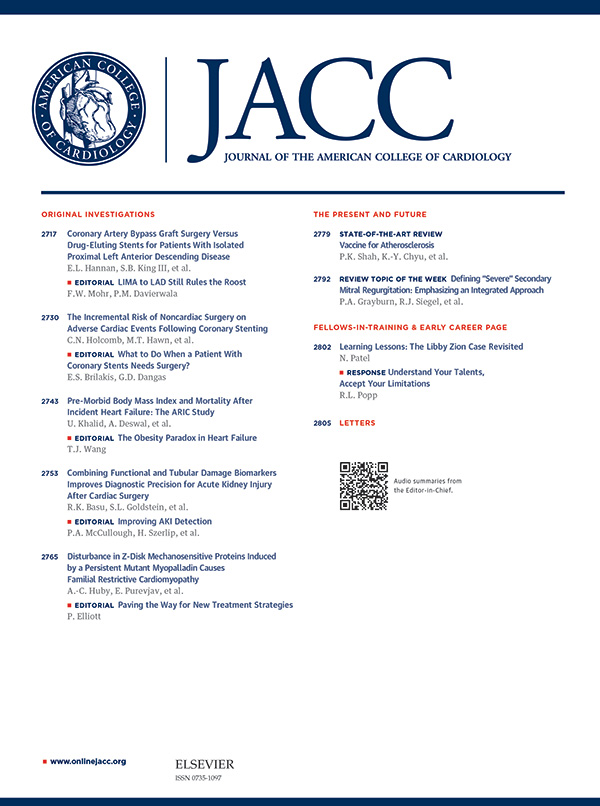JACC in a Flash
Healthy Lifestyle Lowers CV Risk in Diabetic Patients

Greater adherence to an overall healthy lifestyle may be associated with a substantially lower risk of cardiovascular disease incidence and mortality among patient with type 2 diabetes (T2D), according to a study published in the Journal of the American College of Cardiology. Greater improvements in lifestyle behavior after the diagnosis of T2D were also associated with a lower risk of subsequent cardiovascular disease events.
This prospective analysis included participants from the Nurses’ Health Study (NHS) and the Health Professionals Follow-Up Study (HPFUS) who were diagnosed with T2D during follow-up. All participants were free of cardiovascular disease and cancer at the time of their diabetes diagnosis. Lifestyle factors included a high-quality diet (top two-fifths of Alternative Healthy Eating Index), vigorous-intensity physical activity (≥150 minutes weekly) and drinking alcohol in moderation (5-15 g/day for women and 5-30 g/day for men). Lifestyle factors before and after T2D diagnosis were repeatedly assessed every two to four years. Read More >>>

A total of 11,537 adults with T2D were included in the present analysis (8,970 women from NHS and 2,557 from HPFUS). The proportions of participants with zero, one, two and more than three low-risk lifestyle factors at diabetes diagnosis were 6.6 percent, 45.9 percent, 34.6 percent and 12.9 percent among women and 3.0 percent, 31.7 percent, 37.8 percent and 27.4 percent among men, respectively. Over 13.3 years of follow-up, 2,311 incident cardiovascular disease cases and 858 cardiovascular disease deaths occurred.
After multivariate adjustment of covariates, the low-risk lifestyle factors after diabetes diagnosis were each associated with a lower risk of cardiovascular disease incidence and cardiovascular disease mortality. The multivariate-adjusted hazard ratios for participants with more than three low-risk lifestyle factors compared with none were 0.48 for total cardiovascular disease, 0.53 for coronary heart disease, 0.33 for stroke and 0.32 for cardiovascular disease mortality (p trend <0.001 for all). The population-attributable risk for poor adherence to the overall healthy lifestyle (< three low-risk factors) was 40.9 percent for cardiovascular disease mortality.
Greater improvements in healthy lifestyle factors after diabetes diagnosis were also significantly associated with a lower risk of cardiovascular disease incidence and cardiovascular disease mortality. For each number increment in low-risk lifestyle factors, there was a 14 percent lower risk of incident total cardiovascular disease, a 12 percent lower risk of coronary heart disease, a 21 percent lower risk of stroke, and a 27 percent lower risk of cardiovascular disease mortality (p<0.001 for all).
“Our findings indicate that adherence to a healthy diet and lifestyle after diabetes diagnosis is associated with a substantially lower risk of cardiovascular disease incidence and cardiovascular disease mortality among adults with incident diabetes,” the authors conclude. “These findings further support the current recommendation that patients with diabetes should practice a healthy lifestyle to improve their health and maintain a lower risk of developing cardiovascular complications.”
Liu G, Li Y, Hu Y, et al. J Am Coll Cardiol 2018;71:2867-76.
Subclinical AFib Associated with HF Hospitalizations in Some Patients

In patients with a pacemaker or defibrillator, subclinical atrial fibrillation (AFib) progression is strongly associated with hospitalization due to heart failure (HF), according to a study published in the Journal of the American College of Cardiology.
Jorge A. Wong, MD, MPH, et al., examined data from 415 patients enrolled in the ASSERT trial who had experienced an episode of subclinical AFib lasting longer than six minutes but less than 24 hours during the first year after enrollment. Patients in the ASSERT trial were ≥65 years, had a history of hypertension, no prior clinical AFib and an implanted pacemaker or defibrillator. Read More >>>
The reseachers evaluated the predictors of subclinical AFib progression, defined as the development of at least one episode of subclinical AFib >24 hours in duration or clinical AFib in patients previously monitored for one to four years during which they only experienced subclinical AFib lasting between six minutes and 24 hours. Using time-dependent Cox models, they evaluated the relationship between subsequent development of subclinical AFib >24 hours or clinical AFib and HF hospitalization.
Over the two-year mean follow-up, 65 patients (15.7 percent) progressed to having subclinical AFib episodes >24 hours or clinical AFib (incidence, 8.8 percent per year). Among the patients who progressed, 60 patients developed subclinical AFib >24 hours, 25 patients developed clinical AFib and 20 patients developed both.
"This study demonstrates that progression of subclinical AFib, from shorter to longer episodes, is associated with a five-fold increase in the risk of HF hospitalization." — Jorge A. Wong, MD, MPH
Patients who had progression, compared with those who did not, had the longest episodes of subclinical AFib during the first year after enrollment (median, 6.7 vs. 2.0 hours; p<0.001). There were no other differences between the two groups.
Independent predictors of subclinical AFib progression were older age, greater body mass index (BMI) and longer subclinical AFib duration within the first year. Every 10-year increase in age was associated with a 1.6-fold increase in the risk of subclinical AFib progression (hazard ratio [HR], 1.59; p=0.028). For BMI, each 10 kg/m2 increase was associated with an HR of 1.83 (p=0.013). Each one-hour increase in the duration of the longest subclinical AFib episode within the first year of enrollment was independently associated with a 13 percent increase in the risk of subclinical AFib progression (HR, 1.13; p<0.001).
The rate of HF hospitalization among patients with subclinical AFib progression was 8.9 percent per year compared with 2.5 percent per year for those without progression. After multivariable adjustment, subclinical AFib progression was independently associated with HF hospitalization (HR, 4.58; p=0.004). Similar results were observed when excluding patients with a prior history of HF (HR, 7.06; p=0.005) or when defining the development of subclinical AFib progression as subclinical AFib >24 hours alone (HR, 3.68; p=0.016).
The authors write that this is the first study to use continuous, long-term monitoring to prospectively examine the outcomes of AFib progression and thus addresses many of the limitations of prior studies. “This study demonstrates that progression of subclinical AFib, from shorter to longer episodes, is associated with a five-fold increase in the risk of HF hospitalization,” the authors write. They add that “Progression of AFib may be a suitable preventive and therapeutic target and is worthy of future studies.”
Wong JA, Conen D, Van Gelder IC, et al. J Am Coll Cardiol 2018;71:2603-11.
Leaflet Thrombosis Not Associated with Death, Stroke After TAVR

Leaflet thrombosis is not associated with increased mortality or rates of stroke in post transcatheter aortic valve replacement (TAVR) patients, according to a study published in JACC: Cardiovascular Interventions.
Philipp Ruile, MD, et al., performed a single-center observational study of patients diagnosed with leaflet thrombosis shortly after TAVR implantation (median five days) between May 2012 and June 2017. All patients undergoing TAVR were treated with aspirin or aspirin plus clopidogrel postoperatively for six months followed by lifelong low-dose aspirin. Between May 2012 and May 2015, all patients with confirmed leaflet thrombosis were treated with anticoagulation plus clopidogrel for three months (or until thrombosis resolved). After May 2015, patients with leaflet thrombosis were treated with dual antiplatelet therapy unless they had a separate indication for anticoagulation. Read More >>>
A total of 1,424 patients received transcatheter heart valves (THVs) during the study period and computed tomography angiogram (CTA) was performed in 754 (53 percent) of these patients. Leaflet thrombosis was found in 120 patients who received CTA (15.9 percent). Patients with leaflet thrombosis were less likely to be men than women (36.7 vs. 47.0 percent; p=0.045) and had a lower rate of atrial fibrillation than those without leaflet thrombosis (28.3 vs. 41.5 percent; p=0.008).
There were no significant differences in peri- and post-procedural characteristics between patients with and without leaflet thrombisis. Mean pressure gradient was similar between groups at the time of CTA (11.3 mm Hg vs. 12.0 mm Hg; p=0.229). There was no significant difference in the number of patients on anticoagulation at discharge among those without (n=261; 41.2 percent) and with (n=51; 42.5 percent; p=0.840) leaflet thrombosis.
"[T]he data presented here add to the growing evidence indicating that [leaflet thrombosis] has no impact on short- and medium-term mortality." — Philipp Ruile, MD, et al.
The median follow-up period for the overall cohort was 406 days. The mortality per year for the entire study cohort was 11.1 percent (n=124). In patients with leaflet thrombosis the mortality per year was 11.1 percent (n=15) and in those without leaflet thrombosis it was 11.2 percent (n=109). In univariate analysis, neither leaflet thrombosis (hazard ratio, 0.38; p=0.350) nor the other tested variables (age, male sex, atrial fibrillation) were predictive of stroke or transient ischemic attacks (TIAs). The incidence of stroke or TIA in the study cohort was too low to perform a meaningful multivariate analysis.
“[T]he data presented here add to the growing evidence indicating that [leaflet thrombosis] has no impact on short- and medium-term mortality,” the authors write. “The fact that [leaflet thrombosis] represents a relatively benign condition is further supported by comparable rates of stroke in patients with and without [leaflet thrombosis], in line with previous studies.”
Ruile P, Minners J, Breitbart P, et al. JACC Cardiovasc Interv 2018;11:1164-71.
Home-Time Reduced for Hospitalized HF Patients

Home-time, or the time a patient spends alive and out of a health care institution, is substantially reduced for many patients following hospitalization for heart failure (HF) and is highly correlated with traditional time-to-event mortality and hospitalization outcomes, according to research published in the Journal of the American College of Cardiology.
Stephen J. Greene, MD, et al., linked data from Get With the Guidelines-Heart Failure to Medicare inpatient patient claims data, skilled nursing facility claims data and the beneficiary summary file from January 1, 2011 to December 31, 2014. The primary outcome was post discharge home-time. Secondary outcomes included death and the composite of death or all-cause readmission. Home-time was calculated at 30 days, one year and two years post initial hospitalization discharge. Read More >>>

A total of 59,736 patients were included in the study. Mean age was 80.7 years, median ejection fraction (EF) was 50 percent, and 84.4 of patients were white. The most common comorbidities included atrial fibrillation, diabetes, anemia and chronic renal insufficiency. Disposition at time of discharge was home (43.7 percent), with an additional 25.6 percent discharged home with home care, 21.6 percent discharged to skilled nursing facility and 4.1 percent discharged to hospice.
Home-time showed a strong positive correlation with time free from death and time free from the composite of death or HF readmission. The strongest correlation was seen at two years and a modest correlation was seen at 30 days. Conditions that were associated with reduced home-time at one and two years included anemia, chronic renal insufficiency, chronic obstructive pulmonary disease, diabetes, dementia and malnutrition.
There was no significant difference in total post discharge home-time by EF group: 240.5 days for reduced EF and 249.5 days for borderline EF (40-49 percent) (p=0.12). Morality rate at one year (40.6 percent) and the contribution of death to reduced home-time was greatest among patients with reduced EF. The reduction in home-time at 30 days was due to discharge to skilled nursing facility, while death was the reason for the reduction in home-time at one and two years.
An increase in home-time showed a high degree of correlation with time free from death and the composite of death or HF hospitalization at the one- and two-year follow-up.
The authors write that home-time is a novel, easily measured, patient-centered endpoint that may reflect the effectiveness of interventions in future studies. It is easier for patients and families to understand the severity of disease.
Home-time, or the lack of, can represent the risk of mortality and morbidity associated with HF, including the burden of repeated hospitalizations, hospitalization complexity and length of stay, and time spent in rehabilitation and nursing facilities.
Greene SJ, O’Brien EC, Mentz RJ, et al. J Am Coll Cardiol 2018;71:2643-52.
Keywords: ACC Publications, Cardiology Magazine, Anemia, Angiography, Aspirin, Atrial Fibrillation, Body Mass Index, Comorbidity, Coronary Disease, Defibrillators, Defibrillators, Diabetes Mellitus, Type 2, Diabetes Mellitus, Epidemiologic Studies, Exercise, Follow-Up Studies, Heart Failure, Heart Valves, Home Care Services, Hospices, Hospitalization, Hypertension, Inpatients, Ischemic Attack, Transient, Length of Stay, Life Style, Malnutrition, Medicare, Multivariate Analysis, Neoplasms, Pacemaker, Artificial, Patient Readmission, Proportional Hazards Models, Prospective Studies, Pulmonary Disease, Chronic Obstructive, Renal Insufficiency, Chronic, Risk Factors, Skilled Nursing Facilities, Stroke, Stroke Volume, Thrombosis, Ticlopidine, Tomography, Transcatheter Aortic Valve Replacement
< Back to Listings

